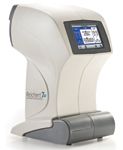Novel auto tonometer helps with diagnosis, treatment
The AccuPen hand-held applanation tonometer is a newer portable device for measuring intraocular pressure that has been designed for reliable performance and easy economical use.

The novel auto tonometer incorporates the bidirectional applanation technology used in the ocular response analyzer (ORA) (Reichert Ocular Response Analyzer) to quantify the biomechanical properties of the cornea and determine IOPcc. The device is intended to help clinical practitioners with diagnostic and treatment decisions, whereas the ORA is used in research settings and in specific settings of glaucoma and cornea care.
Using non-contact (air-puff) technology, the auto tonometer simultaneously provides an IOP measurement similar to that obtained with the Goldmann applanation tonometry (GAT) and other current tonometers (referred to as Goldmann-correlated IOP or IOPg), as well as the IOPcc, a pressure that is independent of biomechanical artifacts such as corneal viscoelastic properties and thickness.
Source of new data
The combination of measurements provided by the auto tonometer could provide important information about two groups of patients, Dr. Radcliffe said. "One is patients with corneal disease, where you're worried that the corneal properties might interfere with pressure measurements, and the other is glaucoma patients, where corneal properties may be masking elevated [IOP]."
He cited a recent study by Tetsuya Morita, MD, investigating IOP measurement values in eyes with normal tension glaucoma (NTG) using GAT, the ORA, and a third tonometer that is also said to be little affected by corneal biomechanical properties. Dr. Morita found that the IOPcc was higher than pressure measured by GAT or the digital contact tonometer (Pascal Dynamic Contour Tonometer, Ziemer Ophthalmology) in patients with NTG, while there was no significant difference between the measurements in normal eyes.
Additional risk factors
"In patients with [NTG], it is likely that we are underestimating the true IOP and that the higher pressure in these patients is at least partially masked by corneal biomechanical properties," Dr. Radcliffe said.
He added that corneal hysteresis-one of the biomechanical properties accounted for by IOPcc-is a risk factor for glaucoma. Incorporating this component helps provide a more complete picture of the IOP values.
"This hasn't been evaluated yet," Dr. Radcliffe said. "It's my hope that by using [IOPcc], not only will we be better able to identify patients with elevated pressure by unmasking the corneal properties, but we'll be better able to assess the effects of our therapy by measuring the pressure more accurately rather than relying on GAT, which measures pressure mixed in with confounding variables explained."
Using an ORA in his practice, Dr. Radcliffe has found a high correlation between IOPg and traditional GAT.
"I would feel pretty comfortable if I had to move away from [GAT] to using the Goldmann-correlated pressure," he said. "I find the ability to know the IOPcc a very important part of my practice. I'm imagining a day when I stop checking GAT and just use IOPg and IOPcc to follow my patients.
"There are other advantages to using a non-contact system," he continued. "For example, not having to anesthetize the cornea or apply fluorescein to test the pressure. Also, research has shown that many Goldmann tonometers are improperly calibrated. Not only are we using an instrument that even on its best days has flaws, but most of us aren't even keeping it calibrated properly."
Interest in corneal biomechanics
There is tremendous interest in corneal biomechanics and its effect on ocular diseases, Dr. Radcliffe added. "It's only a matter of time before we're seeing more [IOPcc] measurements in clinical practice."
In addition to its function in measuring the IOP of glaucoma suspects and patients, the auto tonometer has other potential applications. It could be a valuable tool for measuring IOP in patients who have undergone keratorefractive procedures, which often affect CCT and biomechanics and contribute to inaccuracies in measurements performed with traditional GAT, Dr. Radcliffe said.
"There are a lot of surprises when you start looking at patients with IOPcc and you realize that adjusting pressure by corneal thickness can be misleading in both the magnitude and in the direction of the correction," he concluded.




.png&w=3840&q=75)










